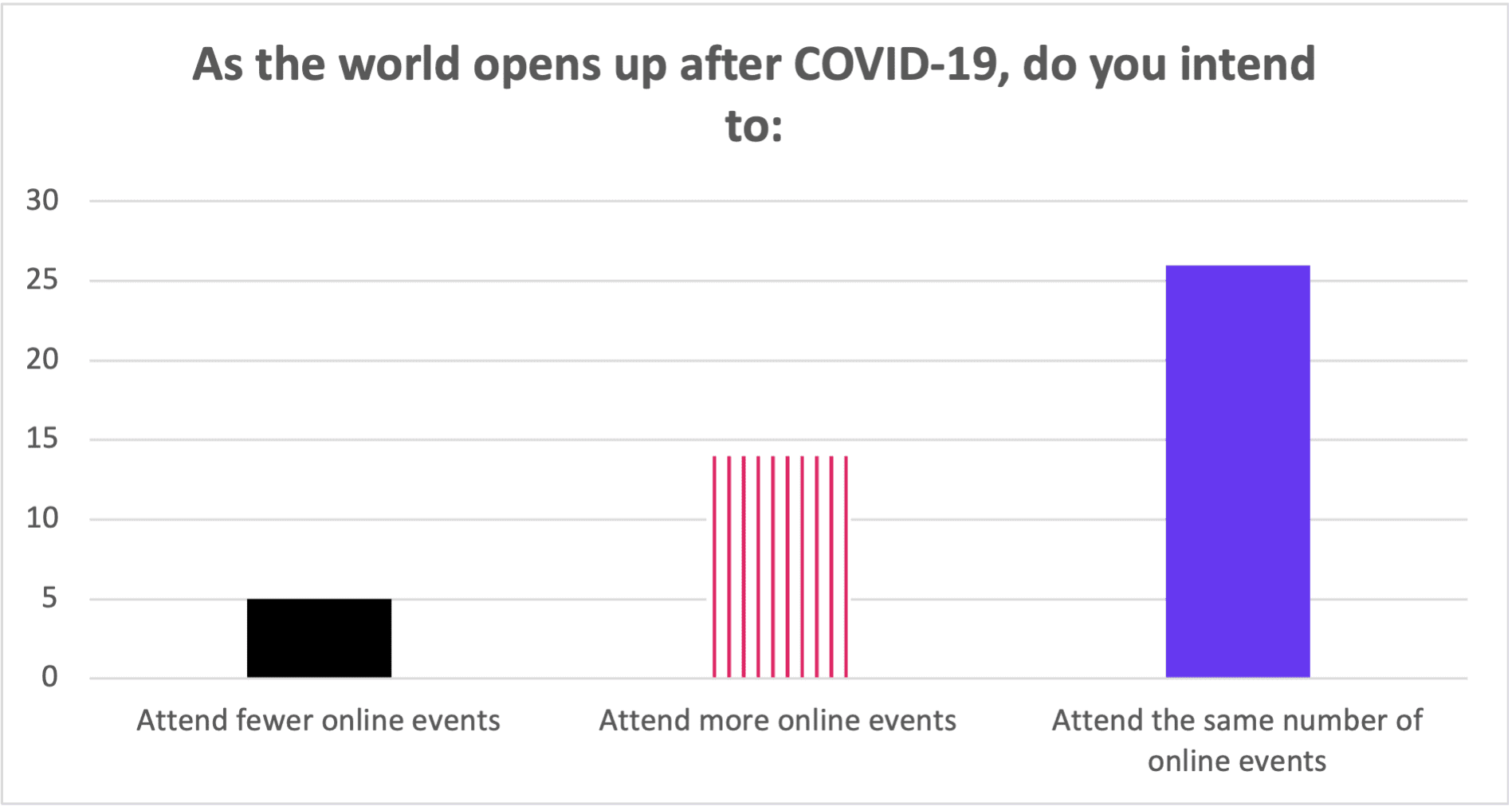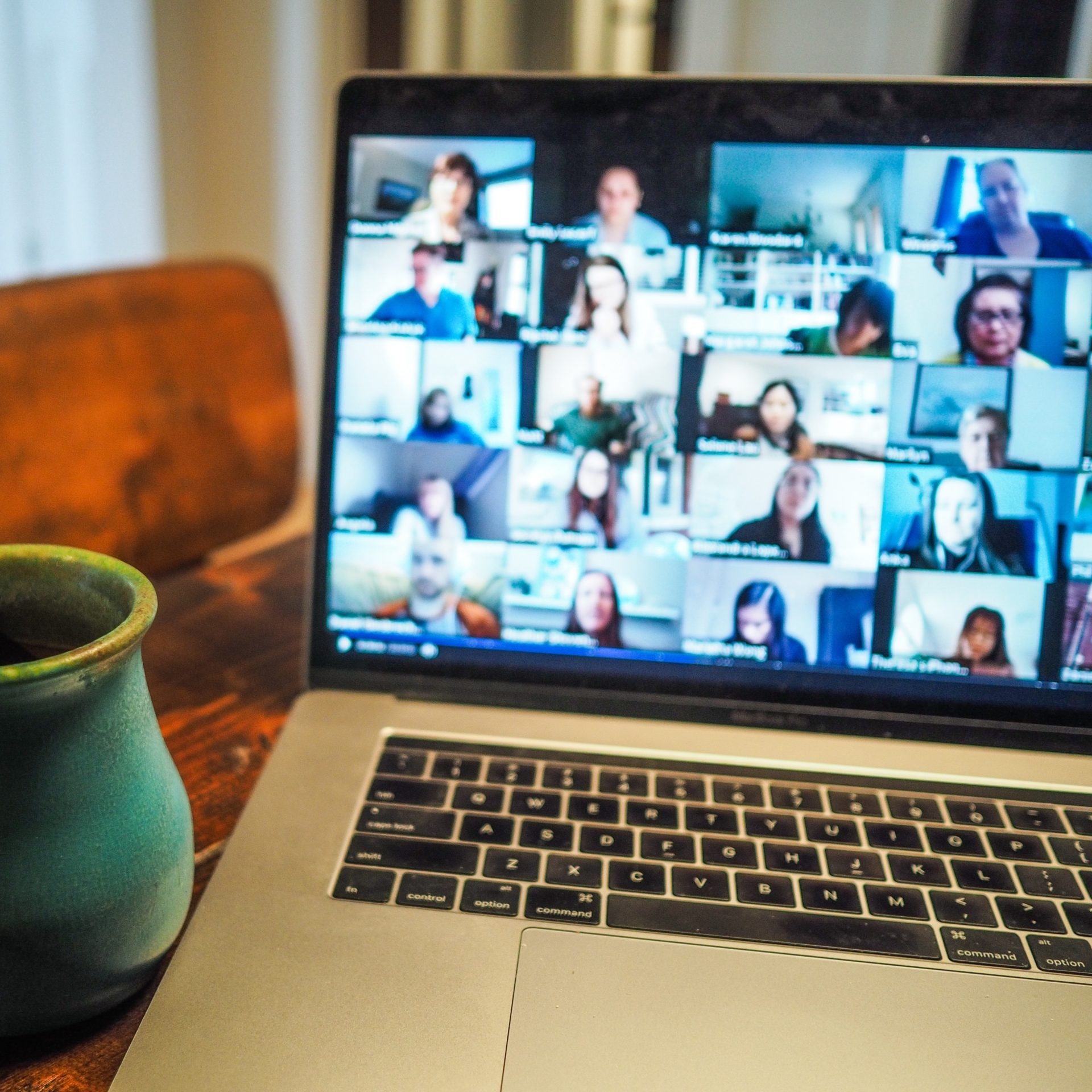
The Accessibility of Online Events: A Retrospective
This past year has seen a massive change in the way we conduct, attend, and participate in events. Thanks to COVID-19, we weren’t often able to gather in-person for industry conferences, corporate events, or hobbyist gatherings. Instead, most socializing moved out of physical spaces, and into online environments.
As part of the online shift, there was a lot of discussion in communities of people with disabilities about how much easier and more inclusive events would become, now that travel, and access to accessible venues, was no longer a requirement. The general consensus was that people with disabilities would be able to attend more events, and be more included, than ever before. But how has that panned out?
After a year of almost exclusively online-only events, Fable conducted a survey of our community of people with disabilities, to learn about their event experiences. We wanted to know if the accessibility and inclusion that we expected became a reality. We also wanted to know what some of the barriers to online events were and to learn what made our community feel most positive about the events they attended.
Were Online Events more accessible?
“As someone with severe mobility issues, I can’t just hop in my car and drive myself to an event. Before going, I have to verify that the venue is easy to get into and get around, I have to rely on someone to drive me in my wheelchair accessible van and then stay with me throughout the event. I have to hope the event is not too crowded for me to navigate the space or too loud for me to be heard, as these are situations that give me a lot of anxiety. The prevalence of online events for the past 20 months has allowed me to attend many that I never could have in person.” – Yvette H
Before we get into the details, let’s not bury the lead. Did our community of people with disabilities find that, as expected, the online events they’ve attended turned out to be more accessible than offline ones?
The answer is yes: 40% said online events turned out to be much more accessible than in-person events, and 49% said they were a little bit more accessible. Only 11% said the accessibility of online events was about the same as in-person events, and nobody found online events to be less accessible.
This strongly supports the belief, both inside and outside of the disability community, that online events are easier and more inclusive for everyone. It also tells us that we have a lot more work to do. If online events don’t require travel, don’t need accessible offline venues, have the potential to make communication and participation more equal for everyone, and are more flexible, why does the majority of the community still find they’re only “a little bit more accessible”?
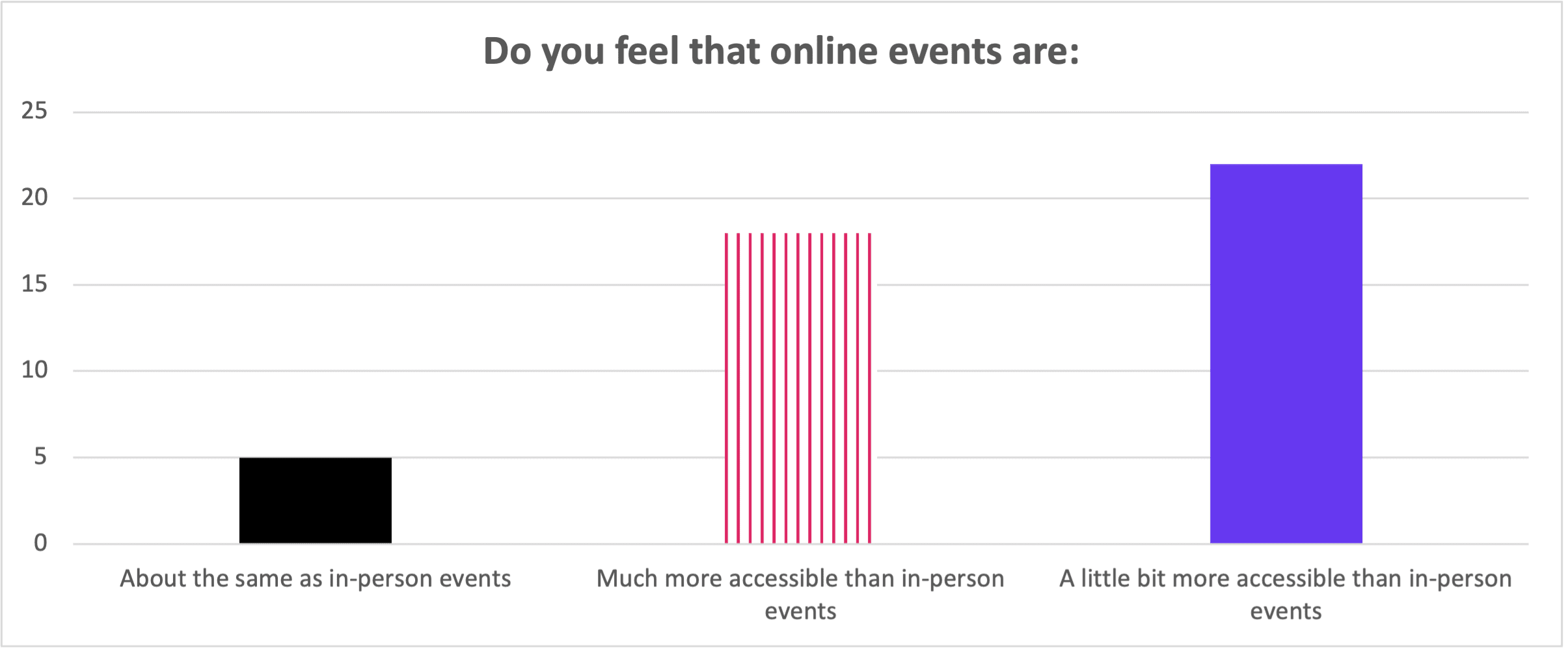
Accessible Platforms
“They used some sort of obscure conferencing system. The conference days started at 8:30 and I never did find the main events that were supposed to happen at that time.” – Martin C
“Although online events don’t require an accessible in-person venue, they do require an accessible platform. This was one of the most frequent areas our community mentioned encountering barriers participating in online events. Some platforms were so confusing that people with disabilities were unable to even find or join the event at all. I have attended events where the color schemes did not provide proper contrast and the chat input areas were not accessible for asking questions.” – Ben P
An event is more than just showing up. Attendees with disabilities want to ask questions, network, interact, and participate just like everyone else. This means event hosting platforms need to do more than just make sure that the basic features are usable. Event platforms need to create easy to use, fully accessible experiences, that put all participants on an equal footing. Otherwise, people with disabilities will continue to be left on the fringes of the events they attend, if they can even get in at all.
When asked about the last event they attended, 45% of people with disabilities encountered accessibility problems that either prevented them from feeling fully included in the event or prevented them from being able to participate at all in some parts of the event.
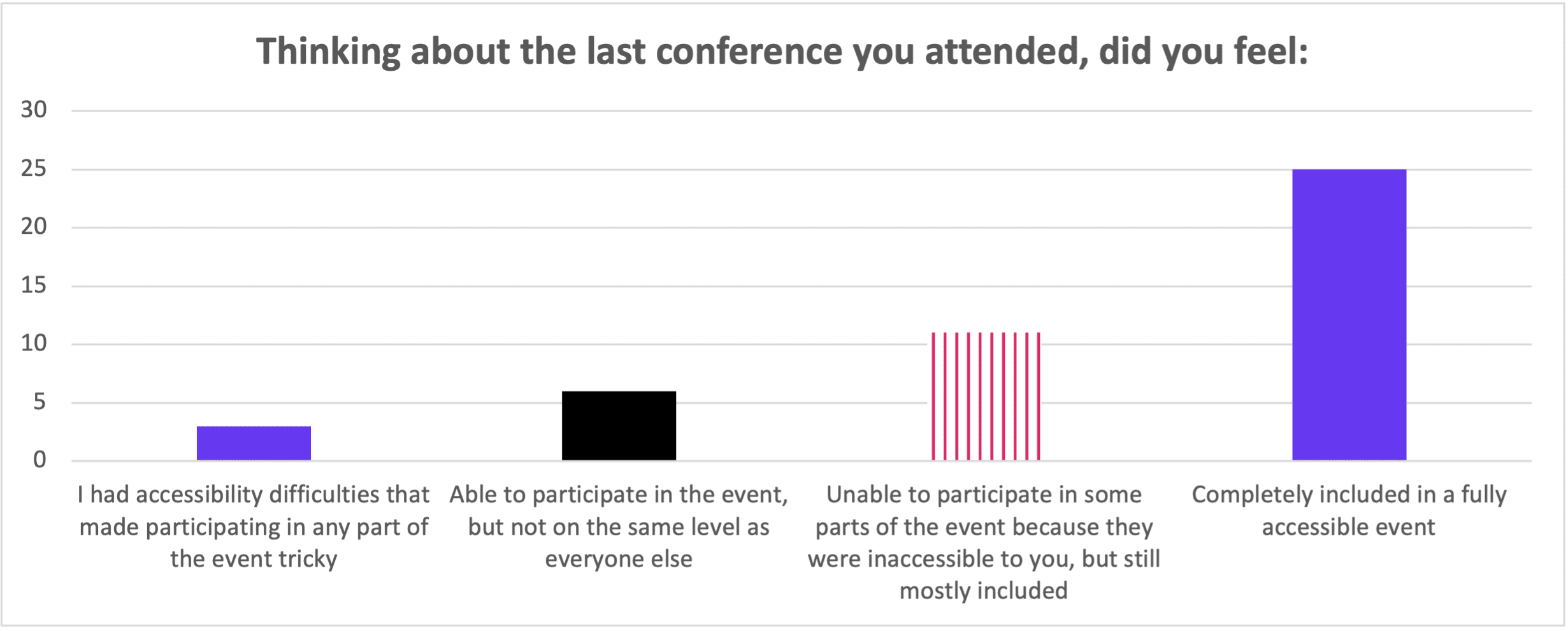
Lack of Accommodations
“People did not care about my suggestions and made comments about my differences. They were not open to doing things differently (i.e., typing in the chat instead of unmuting the microphone to ask a question). People judged me for voicing my opinions.” – Sarah C
For people with disabilities to be fully included in events, it is critical that event organizers go beyond just providing accommodations to those who go out of their way to ask. If an event registration form doesn’t provide a place to ask for accommodations, 49% of people with disabilities will struggle through the event without the accommodations that they may need. When access to event platforms is already challenging, and websites may not be as accessible as they could be, finding the correct person to contact to request accommodations can be extremely difficult. Even if that person is found, people with disabilities may be unsure of the response that they will receive or assume that accommodations just aren’t available. Putting a simple question on the event registration form can lower these barriers and reassure people with disabilities that they are welcome and valued.
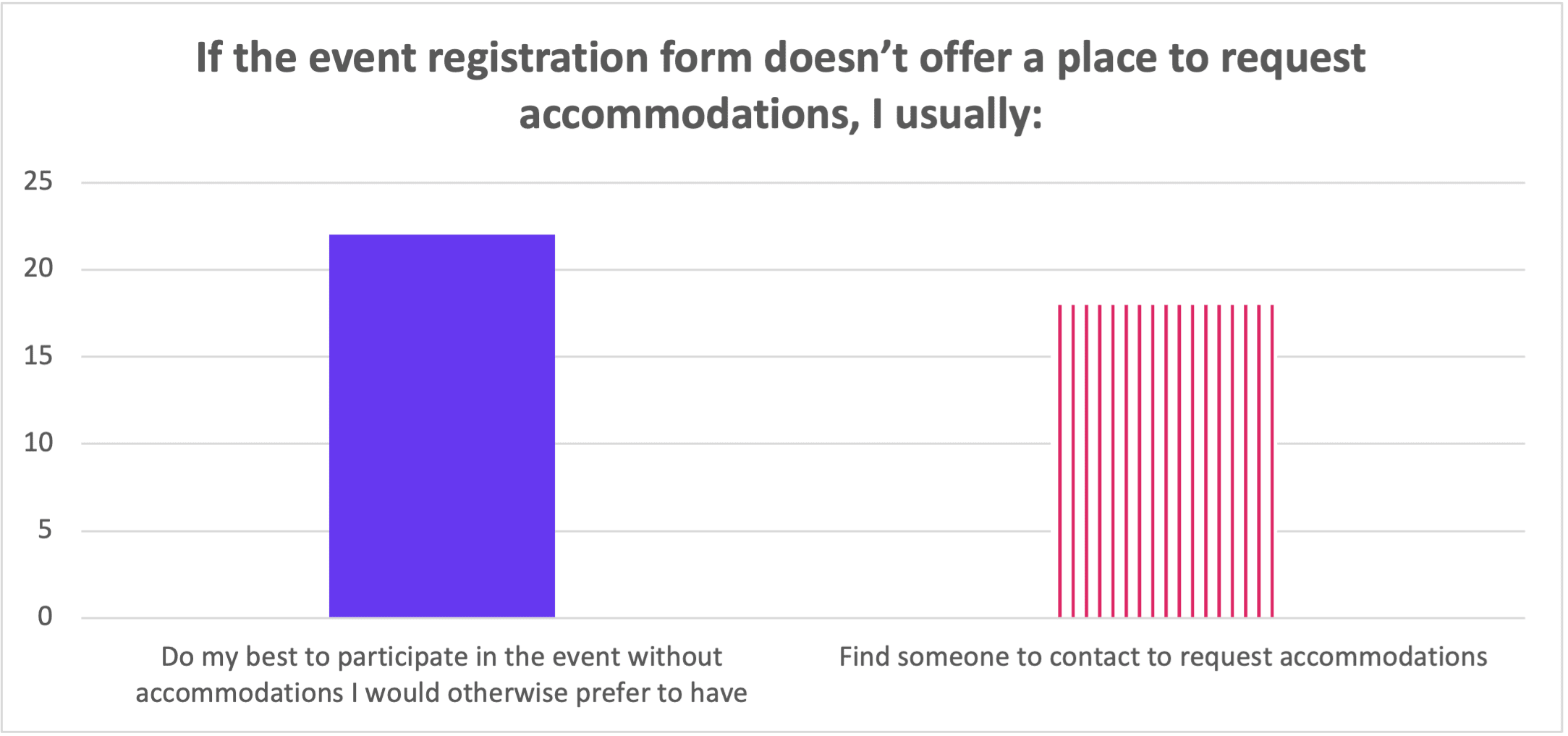
Inaccessible Content
“I once attended a meeting where most of the subject matter was very visual, and I wasn’t able to get materials in advance. Unfortunately, despite the best efforts of the presenter, some of the material just couldn’t be described audibly so I couldn’t understand what was being covered. They tried sharing material via screen share, but the OCR features in JAWS aren’t robust enough to properly translate anything that isn’t perfect machine type font and thus I missed out on key information as it was very detail-oriented.” – Andrew H
Directly related to event accommodations is making sure the content of your event is accessible. One of the most popular accommodations that people with disabilities would like to have is the ability to get access to slides in advance. This helps them make sure that they can access the content, that they understand it, and that they can familiarize themselves with it before the event begins. Providing slides in advance allows people to focus on the chat, the presentation itself, and other opportunities to participate. Popular content related accommodations also include captions and audio description.
What about having presenters describe how they look?
“I don’t find this kind of accommodation to be helpful because the physical appearance of the presenter doesn’t have any effect on my ability to enjoy the presentation as a whole.” – Charmaine C
“I have low vision and recognizing facial features is difficult for me. Having a speaker describe their physical features to me makes them more easily identifiable, especially if two or more event speakers have similar physical features.” – Elizabeth N
This was a question where the community of people with disabilities remains somewhat divided. A third of the community found having presenter describe their physical appearance somewhat helpful, and a third don’t care either way. At Fable, we believe that the most important thing you can do is be intentional about presenter descriptions. First, make sure that presenters know that describing themselves is optional. Accessibility should never be used to force people to describe their apparent race, gender, weight, age, or other visual attributes. However, some presenters may desire to describe themselves, because they do not wish participants with disabilities to misidentify their gender, ethnicity, or other attributes, based on how they sound or speak. It may also be important to the content of the presentation that listeners are aware of something that is visually apparent. For example, someone presenting on physical accessibility may wish to highlight that they are a wheelchair user, or someone presenting on equity and inclusion may wish to highlight their ethnicity, in order to help listeners with disabilities better understand their lived experience.
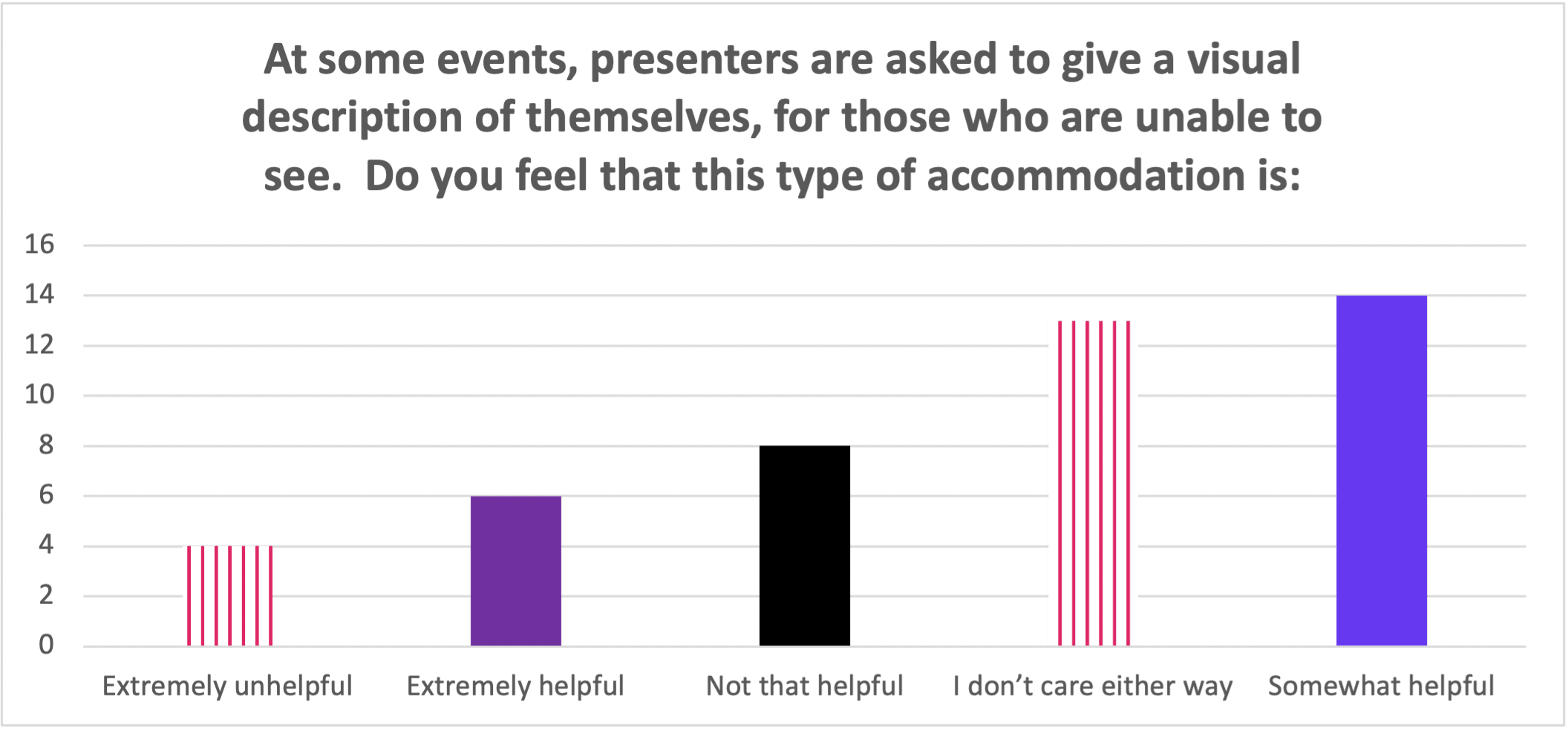
Conclusion
“It was as if the online guests were quite obviously not as important as those in-person. There was no one monitoring the speakers on Zoom much less those who couldn’t speak. There was nothing set up that helped me get in touch with organizers during the event. It was very disheartening.” – Kelly M
The past year has seen the promise of accessibility and inclusivity made by online events begin to come to fruition. But there is still work to do. We need to make sure that the platforms we use to conduct online events are not only accessible but are fully usable. We also need to make sure that when we’re organizing events, we are directly asking participants what accommodations they need, and that we have a plan to provide them. Last, we need to guard against the possibility that as the world opens back up, we don’t lose the accessibility gains that we’ve made over the past year. As we move towards hybrid events, let’s make sure that both online and in-person participants are having an excellent experience; it would be all too easy to treat our online participants as second-class attendees.
As the year draws to a close, let’s all resolve to work towards making 2022 a year of inclusion in every event and conference we host, and every presentation we give. When we do, we’ll find our events enriched by the variety of lived experiences and points of view that only diversity can bring.
